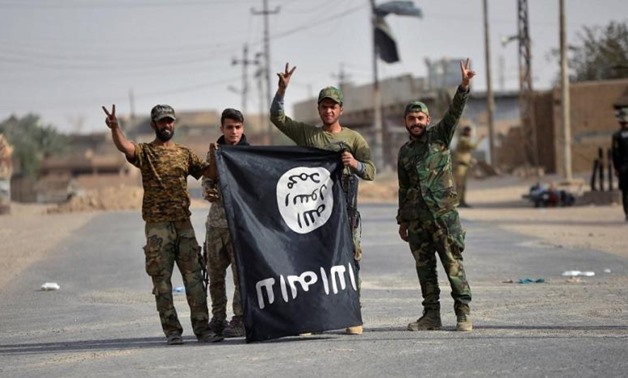
Popular Mobilization Forces fighters carry an ISIS flag downward after liberating the city of al-Qaim, Iraq November 3, 2017. REUTERS
In what turned out to be a decisive victory, the Iraqi army and Hashd al-Shaabi forces liberated the town of Rawa from the Islamic State’s control on Friday. As the last town in Iraq under the control of the brutal jihadist group, this victory indicates a major turning point in the fight against the Islamic State in Iraq.
"Our heroic forces have liberated Rawa district in a record time and will continue purging and securing the border areas," Iraqi Prime Minister Haidar al-Abadi said in a statement on Friday.
This declaration was supported by Lieutenant General Abdul Ameer Rasheed Yarallah, who said in a statement that the Iraqi army and paramilitary forces “liberated Rawa entirely, and raised the Iraqi flag over its buildings.”
The town of Rawa holds strategic and symbolic importance for the Islamic State. The town lies on the Iraqi-Syrian border and exuded significance in the Islamic State’s so-called “Euphrates Caliphate”. The Islamic State highly contests the Sykes-Picot agreement of 1917, and Rawa symbolised the eradication of the artificial borders in the Middle East.
Units from the Iraqi army, Counter-Terrorism Services, and Hashd al-Shaabi instigated an offensive on November 3 to retake the towns of al-Qaim and Rawa which lie on the Syrian border. Al-Qaim was liberated with speed and skill, and the liberation of this important territory signals a major catastrophe for the Islamic State.
The locations, which lie on the Syria-Iraq border, have been vital to the Islamic State’s so-called Caliphate. They facilitate not only the movement of weapons and money, but more importantly people. As IS-controlled territory becomes fragmented and fighters become compressed in tight pockets of control, the ability to move easily, which facilitated their success, is eradicated.
The Islamic State has lost 95 percent of the territory it once held in Iraq since 2014, and the allied Iraqi forces have freed 4.4 million Iraqis from the Islamic State’s chokehold, according to the U.S.-led Coalition.
 ISIS militants wave a flag in Iraq. AFP
ISIS militants wave a flag in Iraq. AFP
Islamic State fighters no longer have control over any significant town or city in Iraq, and it is believed that many Islamic State fighters have fled west into Syria’s eastern Deir Ezzor province. However, the Islamic State’s loss of control over the eastern city of Deir Ezzor on November 3, the capital of the oil-rich eastern province, has compressed IS further into the east of Deir Ezzor province. The Islamic State now holds a small pocket of territory on the Syrian side of the border.
With the collapse of IS control in Iraq, and the recent revelations unveiled by the BBC that in fact thousands of IS soldier and families were shipped from Raqqa to eastern Deir Ezzor, the Syrian army will set its sights on the terror group's last urban stronghold in Syria: the town of Abu Kamal. The Iraqi army controlling its western border, and the Russian-backed and Iranian supported Syrian forces bombarding IS controlled areas of eastern Deir Ezzor, the result is inevitable.
It is likely that the group's leaders and militants will flee, with many heading towards the numerous local refugee camps in the desire to hide among civilians, while many will seek refuge across state borders, most notably with Turkey.
While the destruction of IS’ territory is a powerful reminder that the war against the terror group is a success, it has come with three major setbacks which cannot be ignored.
With the indiscriminate bombing of the major cities under IS control, most notably Raqqa and Mosul, IS has been destroyed but so has everything else. Almost all key infrastructure has faced destruction; beyond this, almost all infrastructure has been destroyed. With people unable to return to the rubble which was once their house, a coordinated approach to regenerate these cities is crucial to a return to normal life and to avoid re-invigorated discontent and violence.
Also, the success of the Russian-backed Syrian government forces and the U.S.-backed Kurdish-dominant SDF forces in Deir Ezzor, raises the question of potential clashes.
As IS’s downward spiral continues, the U.S. and Russia must favor cooperation over competition to avoid an accidental war and establish peace. It should be remembered that the future of Syria must be dictated by the people of Syria, which cannot be overshadowed by great-power politics and the desire to bolster regional influence.
 Iranian Revolutionary Guard Commander Qassem Soleimani uses a walkie-talkie at the frontline during offensive operations against ISIS militants in Salahuddin province March 8, 2015. REUTERS
Iranian Revolutionary Guard Commander Qassem Soleimani uses a walkie-talkie at the frontline during offensive operations against ISIS militants in Salahuddin province March 8, 2015. REUTERS
The situation on the ground in Syria is becoming ever more complex as Qasem Soleimani, his Quds Force, and the overarching IRCG attempt to expand Iran’s already growing sphere of influence. With Iran eager to consolidate its influence, the question of the Trump administration's policy towards Iran gains prominence as Iranian proxies take control and exude power to the Mediterranean and beyond.
With the loss of its short lived self-proclaimed Caliphate, the determined insurgency is expected to invigorate tensions as IS reverts to its roots. As a coordinated effort is gaining success in expelling IS from its territory, IS is attempting to rally Sunnis and rekindle their desire for domination. To avoid IS replicating their previous success through a sustained underground insurgency, the ethnic and religious pendulum in Iraq is in desperate need of re-balancing.
Twitter:



Comments
Leave a Comment